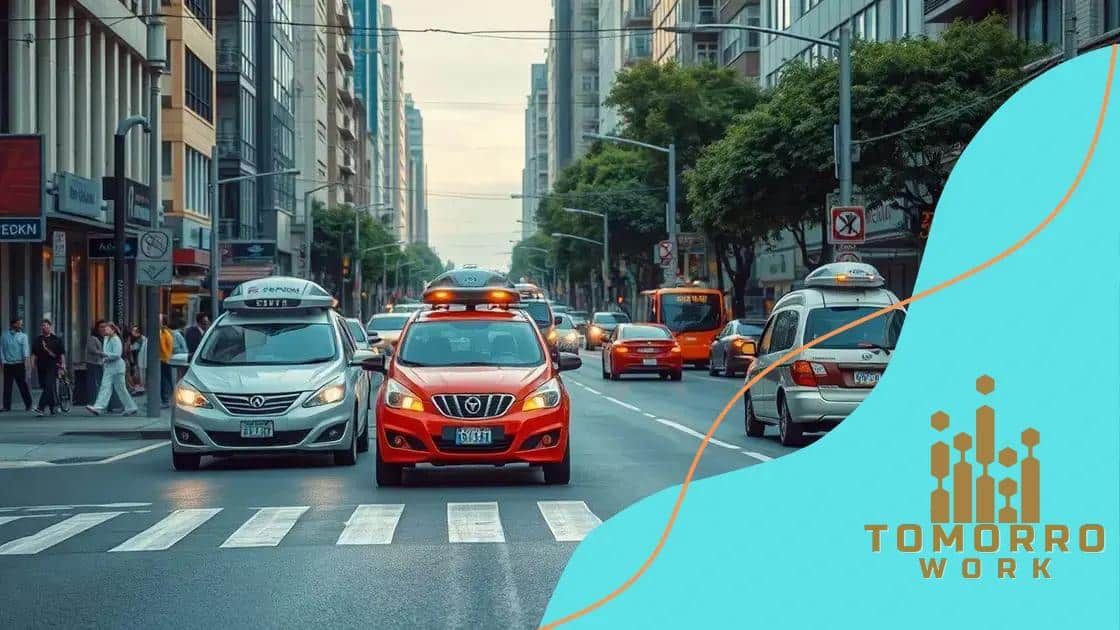How autonomous vehicles are reshaping public transport

Advertisements
Autonomous vehicles are reshaping public transport by enhancing safety, efficiency, and accessibility through electric technology and smart integration, ultimately transforming urban mobility for passengers.
How autonomous vehicles are reshaping public transport is a topic that’s capturing attention everywhere. Have you ever imagined a city where buses and shuttles operate without drivers? In this article, we’ll dive into how this technology could redefine our commuting experience.
Advertisements
Understanding autonomous vehicles
Understanding autonomous vehicles is key to grasping the future of public transport. These vehicles, equipped with advanced technology, can navigate and operate without human intervention. As we explore this topic, it’s essential to look at how these systems function and their potential impact on our transportation systems.
What are autonomous vehicles?
Autonomous vehicles utilize sensors, cameras, and artificial intelligence to drive themselves. The technology behind these cars allows them to understand their environment and make decisions, similar to a human driver.
Key components of autonomous vehicles
- Sensors: Devices that detect objects, surroundings, and changes in the environment.
- Machine Learning: Algorithms that help the vehicle learn from past experiences to improve performance over time.
- GPS and Mapping: Systems that provide location data and help plan routes.
As we delve deeper into the world of self-driving cars, we see that they offer various benefits. For instance, they can reduce traffic accidents caused by human error, promote fuel efficiency, and provide better accessibility for individuals who cannot drive.
Advertisements
With advancements in technology, these vehicles are becoming increasingly capable. They use data from various sources to develop a comprehensive understanding of their environment. This includes recognizing traffic signals, pedestrians, and other vehicles. It’s fascinating to think about how such vehicles will reshape our cities and improve public transport systems.
Moreover, as more autonomous vehicles are integrated into public transport, we could witness significant reductions in operational costs. This can lead to a more efficient and reliable transportation network, encouraging more people to use public transit.
In conclusion, understanding autonomous vehicles is fundamental as we look forward to their potential. With their ability to innovate transportation, they represent a promising future for urban mobility.
The benefits for public transport systems
The benefits for public transport systems that come with the adoption of autonomous vehicles are quite exciting. These advances promise to improve the efficiency and accessibility of urban transportation. Imagine a future where self-driving buses and shuttles enhance the commutes of millions.
Increased safety
One of the primary advantages of autonomous vehicles is their potential to increase safety. With advanced technology that reduces human error, we could see fewer accidents on the roads. Autonomous systems can process information much faster than a human driver, making split-second decisions that enhance safety.
Greater efficiency
Autonomous vehicles can optimize routes and schedules based on real-time traffic data. This level of efficiency means that public transport systems can serve more people while reducing wait times. Passengers benefit from on-demand services that cater to their schedules.
- Reduced operating costs: With fewer drivers needed, transit agencies can save money on labor.
- Lower emissions: Electric autonomous vehicles can reduce carbon footprints, contributing to cleaner cities.
- Improved access: These vehicles can reach underserved areas, making public transport available to more communities.
Furthermore, the incorporation of autonomous technology allows for more flexible transport solutions. For example, smaller autonomous shuttles can adapt to changing demand, picking up passengers from their locations and bringing them to central hubs. This flexibility encourages higher rates of public transport usage.
Moreover, as cities evolve, autonomous public transit can help reshape urban landscapes. With fewer cars on the road, there can be more space for parks and pedestrian areas. This shift not only enhances quality of life but also promotes sustainable urban development.
The impact of autonomous vehicles extends beyond just efficiency and safety. They pave the way for a more innovative integration of transport systems, merging them seamlessly with smart city initiatives. As technology continues to advance, we can expect an even greater transformation in how we navigate our cities.
Challenges of implementing autonomous technology

Challenges of implementing autonomous technology in public transport systems present numerous obstacles that must be addressed for successful integration. While the benefits are compelling, understanding the hurdles is crucial for stakeholders.
Technical limitations
One significant challenge is the technical limitations of current technologies. Although sensors and algorithms have made great strides, they still struggle with complex driving situations, such as unpredictable weather or heavy traffic. These limitations can affect the reliability of autonomous vehicles.
Regulatory hurdles
Another challenge is navigating the complex regulatory environment. Governments and agencies need to establish clear rules and guidelines regarding the operation of autonomous vehicles. This includes safety standards, insurance policies, and liability issues.
- Safety regulations: Ensuring that autonomous vehicles meet rigorous safety standards before being approved for public use.
- Data privacy: Protecting the data collected by these vehicles while they operate in public spaces.
- Legislation: Developing laws to address interactions between human drivers and autonomous vehicles.
Furthermore, public perception plays a significant role in the adoption of autonomous technology. Many people remain skeptical about trusting self-driving vehicles, which can hinder widespread acceptance. Education and outreach programs will be essential to inform the public about the safety benefits and technological advancements.
Moreover, the integration of autonomous vehicles into existing transport systems can be complex. This involves retrofitting infrastructure, such as traffic signals and roadways, to communicate effectively with these vehicles. It also means coordinating with current public transport operators and aligning their services with autonomous options.
Additionally, there are economic factors to consider. High initial costs for technology development and vehicle acquisition may deter investment. Funding models need to be explored to ensure that the transition to autonomous systems is financially viable for public transport agencies.
Real-world examples of autonomy in transport
Real-world examples of autonomy in transport showcase how self-driving technology is making significant strides across the globe. Several cities are actively testing and implementing autonomous vehicles within their public transport systems.
Autonomous shuttles
Many cities have introduced autonomous shuttles as a pilot program to enhance public transport. For instance, in San Francisco, a fleet of self-driving shuttles operates in designated areas, providing a safe and efficient way for residents to travel. These shuttles are designed to blend into everyday traffic.
Self-driving buses
Another fascinating example is the use of self-driving buses in various locations worldwide. In Lyon, France, the city deployed autonomous mini-buses that run on a fixed route. These buses allow for easy access to areas that might be underserved by regular transit options.
- Gothenburg, Sweden: The city hosts a pilot program with self-driving buses, characterized by a smart transport system aimed at reducing traffic congestion.
- Las Vegas, Nevada: Here, the first autonomous shuttle service offered free rides on the Strip, demonstrating the feasibility of integrating self-driving vehicles into busy urban environments.
- Australia: In various Australian cities, shuttle services have been introduced in isolated regions, making crucial transport options available.
These real-world examples illustrate the growing acceptance and application of autonomous technology in public transport. Each of these initiatives is paving the way for broader adoption and integration of autonomous vehicles.
Additionally, as more cities experiment with this technology, they provide valuable data and insights that can be used to improve future implementations. The success of these projects can significantly influence perceptions about the safety and reliability of self-driving transport.
Furthermore, collaborations between software companies and public transit agencies are crucial in developing the systems needed for effective operation. With continued advancements, we can anticipate even more innovative solutions in the realm of public transportation.
Future trends in public transportation
Future trends in public transportation are evolving rapidly as cities incorporate new technologies and practices. The focus on sustainability and efficiency shapes how we think about urban mobility.
Electrification of public transport
One major trend is the electrification of buses and trains. Many cities are transitioning from diesel-powered vehicles to electric ones to reduce emissions. This shift not only helps the environment but also lowers operating costs in the long run. Electric vehicles are quieter and offer a smoother ride, which can improve the public’s experience.
Integration of smart technologies
Another trend is the integration of smart technologies into public transport systems. With the use of apps and real-time data, commuters can access information about schedules and routes more conveniently. For instance, many transit agencies are implementing systems that provide live updates on arrival times, which helps passengers plan their journeys effectively.
- Contactless payments: Many systems are moving towards cashless transactions, allowing passengers to pay for fares using smartphones or contactless cards.
- Advanced booking systems: Apps enable users to reserve seats in advance, making public transport more user-friendly.
- Data analytics: Transit agencies can analyze ridership data to identify trends and improve services based on actual usage patterns.
Moreover, the incorporation of autonomous vehicles will likely play a significant role in the future of public transportation. As technology continues to develop, we may see self-driving shuttles become an integral part of the public transport network, enhancing efficiency and accessibility.
Furthermore, there is a growing focus on creating multi-modal transport systems. These systems integrate various modes of transport, such as bikes, ride-sharing services, and public transit, to offer seamless mobility options. This kind of integration can encourage more people to use public transport instead of personal vehicles.
In addition, the emphasis on sustainability means that urban planners are also considering the development of pedestrian-friendly environments. Cities are creating more walkable areas, promoting public transport as a viable alternative to driving.
FAQ – Frequently Asked Questions about Autonomous Vehicles in Public Transportation
What are autonomous vehicles?
Autonomous vehicles are self-driving cars and shuttles that operate without human input using advanced technology.
How do autonomous vehicles improve public safety?
They reduce accidents caused by human error through fast decision-making algorithms and precise sensors.
What role does technology play in public transportation’s future?
Technology enhances public transport through real-time data, contactless payments, and integration of different transport modes.
Are electric buses part of the future of public transportation?
Yes, electric buses are being adopted to reduce emissions and provide a cleaner alternative to traditional fuel-powered vehicles.





